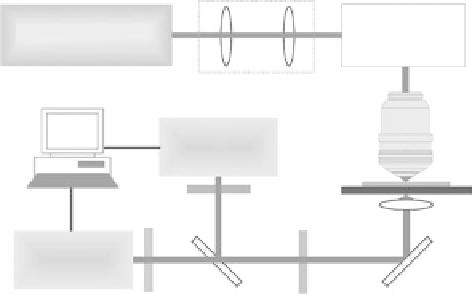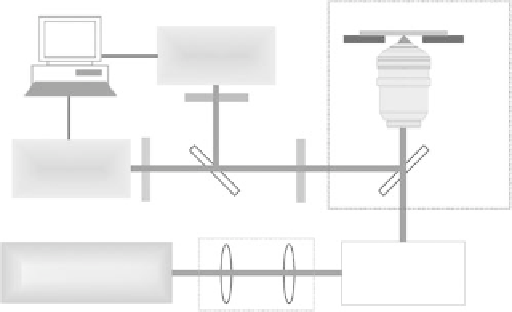Biomedical Engineering Reference
In-Depth Information
(a)
Beam collimator
Cr:F laser
Wavelength: 123 nm
Galvanometer
mirrors
PMT
THG (410 nm)
Objective
Sample
BF
CF
Condensor
PMT
SHG (615 nm)
DBS
BF
(b)
Sample
PMT
THG (410 nm)
Objective
BF
CF
PMT
SHG (615 nm)
DBS
DBS
BF
Beam collimator
Cr:F laser
Wavelength: 123 nm
Galvanometer
mirrors
FIgurE 14.5
Schematic diagrams of the combined SHG/THG microscope with (a) forward-collection
and (b) backward-collection geometry. DBS: dichroic beamsplitter; CF: color filter; BF: bandpass filter; PMT:
photomultiplier.
As the laser beam is 2D scanned point by point over the specimen, the PMTs simultaneously record the
excited harmonic generation signals point by point to form 2D SHG and THG images.
All the combined SHG/THG results discussed in this chapter are obtained using the home-made
1230 nm laser for excitation. The imaging system is adapted from a commercial confocal scanning
system (Olympus, FV300) combined with an upright microscope (Olympus BX51) or an inverted
microscope (Olympus IX71). All optics in the system are modified for the excitation of infrared light
(~1230 nm). All the objectives used in our studies are listed in Table 14.1 along with their perfor-
mances, including the ideal spatial resolution and viewing area. For the backward-collection system,
a dichroic beamsplitter (FF665-Di02 produced by Semrock or 865dcxru from Chroma Technology) is
used to separate the excitation laser beams and generate higher harmonic signals. A dichroic beam-
splitter (490DRXR from Chroma Technology, with a cut-off wavelength at 490 nm) is used for separat-
ing the SHG and THG signals, while R4220P and R943-02 (or R928P) (from Hamamatsu) PMTs are
used for the detection of SHG and THG, respectively. A color filter (CG-KG-5, CVI) is used before
the PMTs to filter out the laser radiation, while the bandpass filters (HQ615/30X and D410/30 from
Chroma) are used to filter the SHG and THG signals, respectively. The commercial software, Fluoview
4.3a (from Olympus) is used for programming, and a frame rate ranging from 1 to 4 Hz is applicable
for a 512 × 512 image.


